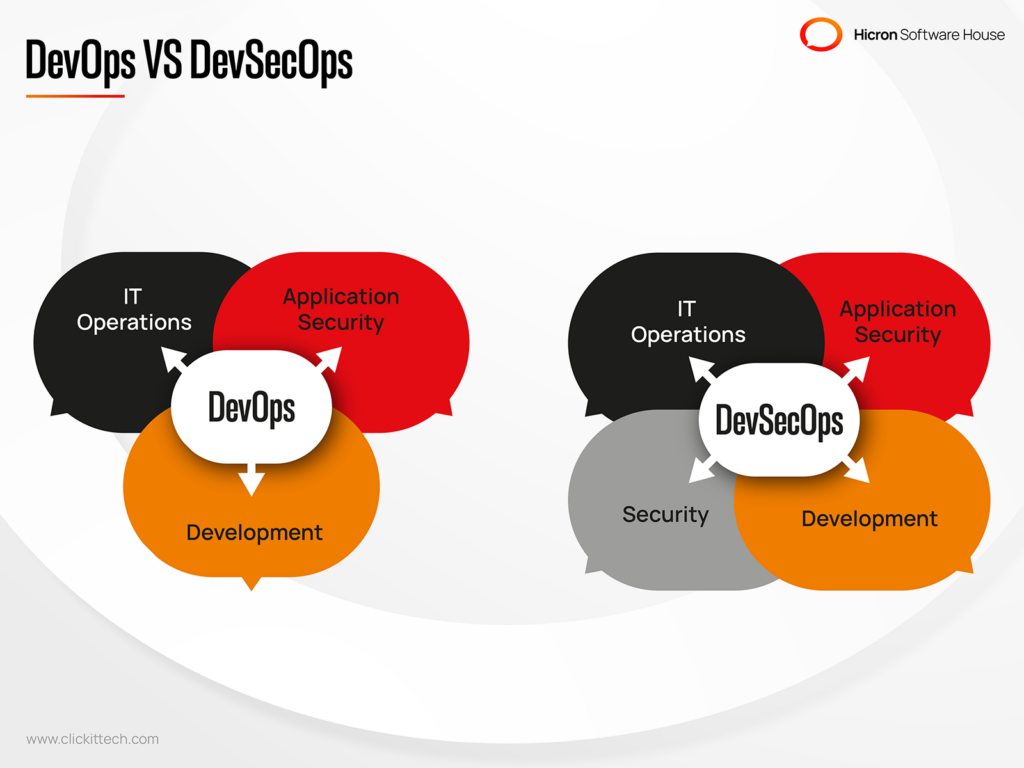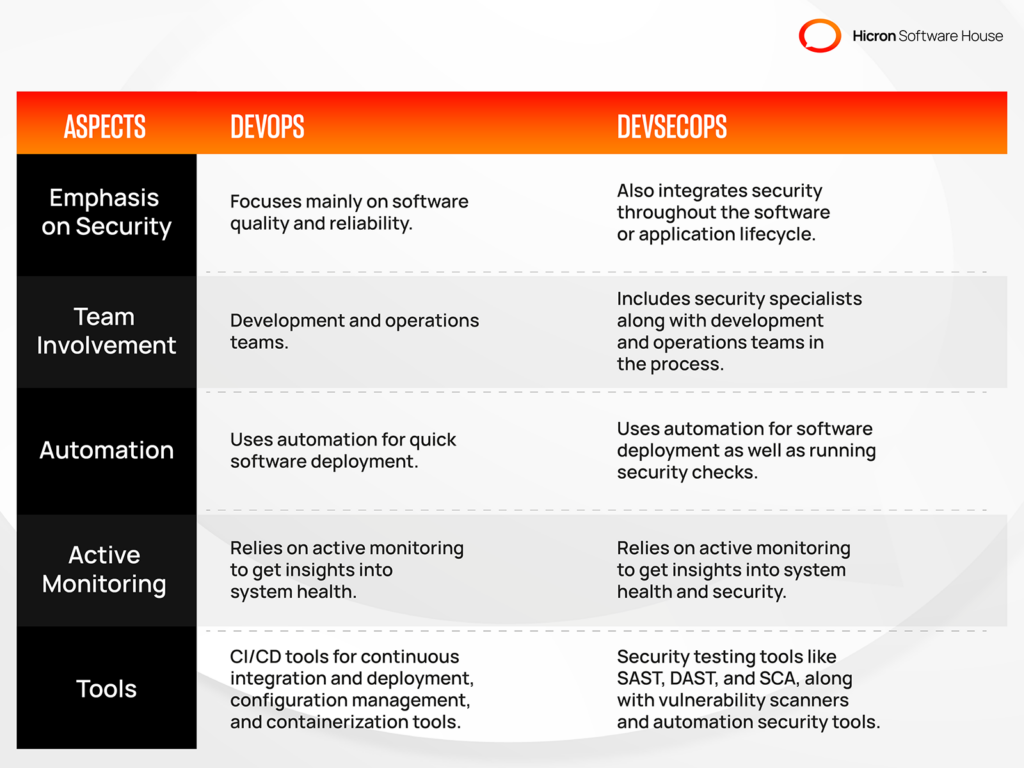How Azure DevOps services differ from Azure DevOps server?
- September 19
- 11 min

The competition in the business world is at an all-time high, necessitating rapid and secure software development and delivery processes. In response to this, two prominent concepts have emerged: DevOps and DevSecOps. It’s important to grasp the distinctions between these terms and comprehend their respective roles in software development to know when to use them.
This article is your complete guide on DevOps vs DevSecOps, their working, and key differences. Continue reading.
DevOps combines software or application development (Dev) and operations (Ops), allowing businesses to quickly commit a code change and deploy it to production within a minimum time.
It involves using different DevOps tools to streamline communication and collaboration between the software development and operations teams. The purpose is to optimize the application delivery and integration process to ensure high customer satisfaction. Here are the various steps involved in DevOps:
At its core, DevOp’s philosophy is to break away from the silos of traditional software development approaches. It focuses on creating an agile and scalable system by involving both development and operational teams throughout the software lifecycle, from planning to build and release.
DevOps revolves around a set of core practices designed to enhance and streamline the software development process. Below is a detailed explanation of each point.
1. Fostering a Culture of Collaboration
Firstly, to make this journey successful, you should create a collaborative environment where your development and operations teams can communicate and engage freely. This is really important as smooth communication between teams breaks down silos and urges them to work together for quick problem-solving.
2. Adoption of CI/CD
Another excellent DevOps practice is the adoption of continuous integration and continuous delivery. CI helps determine how many developed codes are ready for production and also enables early code error detection. The CD focuses on automating the delivery of code changes to a pre-production stage, streamlining the whole software development process.
3. Setting Up Automated Testing
You should also set up automated testing to check your code for every change introduced. This is one of the most important aspects of DevOps, which eliminates the unreliability associated with manual testing, increases testing frequency, and minimizes the chance of errors in the production stage.
4. Focusing on DevOps Observability
DevOps observability is another important part of DevOps that ensures the success of all development initiatives. To achieve high observability, you can use various observability tools that provide insights into system health and help you pinpoint and resolve any issues that may arise during operations.
DevOps goal is to allow DevOps teams to release and deploy high-quality software at a fast rate. However, it also has some other goals, such as:
The workings of DevSecOps are simple: software developers perform strict security testing at each stage of the life cycle. It involves collaboration between system development and operations teams as well as security specialists that make your software solutions secure for end users.
Once a product is complete, it’s sent to security teams, which test the pre-release application for security loopholes and vulnerabilities.
Here’s what DevSecOps stands for:
In DevSecOps, security’s role is to seamlessly integrate protective measures into every phase of the software development lifecycle (SDLC), from design to deployment and beyond.
Shift Left
The first and most important DevSecOps security practice is shift left. This means you should move security checks as early as possible in the software development process. As a result, issues are identified beforehand, resulting in minimum downtime and higher customer satisfaction.
Implementing CI and CD
Implementing CI and CD is also an essential DevSecOps security best practice. These elements ensure that DevSecOps teams can quickly test, build, and deploy code changes without delay or human error.
Threat Modeling
Threat modeling identifies, assesses, and mitigates potential threats to software systems in the early life cycle. It involves creating a visual representation of systems and assets to pinpoint vulnerabilities. Threat modeling works best in the following situations:
Encrypt Moving Data
In an organization, data is swiftly moved from one system to another. So, another DevSecOps security practice is the encryption of this moving data. SSL and TLS are prominent names that encrypt your organizational data and protect it from unauthorized access.
Adopt a Microservice Architecture
Last but definitely not least, one of the DevSecOps best practices is to adopt a microservice architecture. In this, monolithic applications are divided into smaller, manageable parts to implement security controls easily. Besides, it offers other benefits, such as the services being scaled independently. In case of a security issue, the individual service can be updated without having to reset the whole application.
Both DevOps and DevSecOps share many similarities; however, some key differences, like the latter’s emphasis on security, distinguish these approaches. Let’s discuss this in detail.

Emphasis on Security
While both DevOps and DevSecOps focus on streamlining the software development process, the key difference lies in their approach to security. DevOps is all about accelerating software delivery but with top quality and reliability.
On the other hand, DevSecOps integrates security throughout the development life cycle, from planning and coding to testing and deployment. For example, in a DevSecOps environment, security checks are implemented alongside development tasks to produce a secure software solution.
Team Involvement
DevOps typically involves the development (Dev) and operations (Ops) teams. Conversely, DevSecOps has development (Dev), security (Sec), and operations (Ops) teams. In this, you work with security specialists throughout the product life cycle and get guidance and expertise on best security practices, threat modeling, and vulnerability management.
While DevSecOps places a stronger emphasis on security throughout the development lifecycle, both DevOps and DevSecOps share a foundation built on the following similarities:
Here’s an overview of the DevSecOps vs DevOps comparison:

In DevOps vs DevSecOps, both approaches promote team collaboration and rely heavily on automation for various tasks. If you are wondering where to get highly skilled DevOps engineers to streamline your application or software development and deployment, Hicron Software House has you covered. Security is the primary focus of our DevOps professionals, and we ensure your systems are free of bugs and issues.
